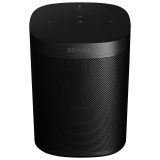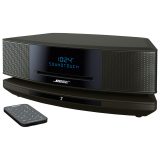 It’s pretty amazing that in a relatively short time span, wireless multi-room audio has become such an easy and affordable option for the masses.
It’s pretty amazing that in a relatively short time span, wireless multi-room audio has become such an easy and affordable option for the masses.
I remember when I was a kid, long ago in the before-times, one of my friends came from an affluent family, and they had speakers in every room of their spotless and opulent mansion. I think it was a mansion. I was a little kid, so it may actually have been smaller than I remember. Also, it probably wasn’t spotless or opulent. It was just nicer than my home. But, what I do recall with vivid clarity was that in every bathroom, in every bedroom, the living rooms (there were two) the kitchen and basement area, there was at least one speaker, positioned perfectly to fill the room with music. It was all controlled by an elaborate sound system with multiple components, housed in a recessed area in the main hallway. From there, my friend’s parents could direct music wherever they wanted. I also vividly remember my parents talking about how expensive it would be to have something like that installed in a home, with all the wiring in the walls and pricey speakers and half a dozen or so stereo components.
But today, you don’t need a snake’s nest of wires, heavy-duty installation or even a complicated and expensive multi-component stereo system to have really good sound everywhere in your home. Now, there are plenty of options and plenty of brands from which to choose, and all easily controlled with the touch of a button on your smartphone, or even with your voice. So, ready to give your living spaces the gift of sound? Then let me tell you everything you need to know about wireless multi-room audio.
How does multi-room audio work?
As you would imagine, a multi-room audio system typically is made up of a series of speakers that are linked together with some sort of stereo amplifier or music streaming component connected as part of a network. Of course, considering we’re talking about wireless multi-room speakers, you could use just one speaker or soundbar and move it around the house for the same effect. That’s not really what we want, right? We want a permanent setup, so we can stream music easily anywhere we want.
The two main ways multi-room audio systems work is by using your existing Wi-Fi network, or by creating a mesh network of its own. It’s important to keep in mind that different systems use different ways to connect and network, so make sure you are not mixing and matching incompatible speakers. Make sure you are happy with your choice of platform/network environment, too, as it will be difficult to change things up after you start investing in speakers. The vast majority of multi-room systems connect and communicate using your home’s wi-fi network. This means they are reliant on the strength and stability of your network and will have an impact on your overall network bandwidth.
Which wireless multi-room audio system to buy?
That’s the million-dollar question, right? You will find multi-room audio systems in a wide range of shapes and sizes, at varying price points, and from a plethora of recognizable brands. However, there are a few major players you should be aware of if you’re planning to take the multi-room audio plunge.
Sonos
 One of the most well-known names in the multi-room audio world is Sonos. The company uses its own Wi-Fi mesh network, rather than Bluetooth (and your Wi-Fi network) which is awesome if you don’t want any bandwidth interruptions. As with most multi-room brands worth their salt on the market, Sonos has its own app that you use on your smart devices to control the sound across your multi-speaker setup. The Sonos One – Voice Controlled Smart Speaker with Amazon Alexa is a great starting point for a multi-room system, as its easy to use, has voice controls with Amazon Alexa, and Sonos One wirelessly connects to Sonos speakers in additional rooms, allowing you to expand your Home Sound System when you’re ready.
One of the most well-known names in the multi-room audio world is Sonos. The company uses its own Wi-Fi mesh network, rather than Bluetooth (and your Wi-Fi network) which is awesome if you don’t want any bandwidth interruptions. As with most multi-room brands worth their salt on the market, Sonos has its own app that you use on your smart devices to control the sound across your multi-speaker setup. The Sonos One – Voice Controlled Smart Speaker with Amazon Alexa is a great starting point for a multi-room system, as its easy to use, has voice controls with Amazon Alexa, and Sonos One wirelessly connects to Sonos speakers in additional rooms, allowing you to expand your Home Sound System when you’re ready.
Bose
 Bose is a huge name in audio, so it makes sense the company is also big when it comes to multi-room audio. The Bose ecosystem is called SoundTouch, which connects via Wi-Fi, but also supports Blurtooth networking, and includes a range of speakers, soundbars and all-in-one systems, such as the Bose Wave SoundTouch IV Wireless Multi-Room Music System. The SoundTouch system works together with other Wave speakers, letting you create a multi-room listening experience. With multiple systems you can easily listen to the same music throughout your home or different music in different rooms.
Bose is a huge name in audio, so it makes sense the company is also big when it comes to multi-room audio. The Bose ecosystem is called SoundTouch, which connects via Wi-Fi, but also supports Blurtooth networking, and includes a range of speakers, soundbars and all-in-one systems, such as the Bose Wave SoundTouch IV Wireless Multi-Room Music System. The SoundTouch system works together with other Wave speakers, letting you create a multi-room listening experience. With multiple systems you can easily listen to the same music throughout your home or different music in different rooms.
Samsung
 Samsung is another audio name brand everyone should be familiar with. Its speakers rely on their own mesh network to talk to each other and play music without being interrupted. Its products, such as the Samsung Radiant 360 R3 Audio Bluetooth Wireless Speaker, use a multi-room app to connect and expand its network.
Samsung is another audio name brand everyone should be familiar with. Its speakers rely on their own mesh network to talk to each other and play music without being interrupted. Its products, such as the Samsung Radiant 360 R3 Audio Bluetooth Wireless Speaker, use a multi-room app to connect and expand its network.
In addition to those names, you will also find wireless multi-room audio from audio companies such as Denon Heos, Bang & Olufson, Harman Kardon, and more. You don’t need to stick to one brand though, as things like Apple Airplay2 or Google Chromecast are compatible with multiple brands of wireless speaker and sound bars. Chromecast is cool, because it offers a Chromecast Audio dongle that can be plugged into speakers, whether they be Bluetooth or part of a hi-fi system via a 3.5mm connection, turning them into Wi-Fi enabled multi-room speakers instead.
It’s a hard choice, as you’ll find lots of different options, but look at your budget, or how much you are willing to spend, and divide that by the number of rooms you want to have wired (or rather wireless) for sound. If you use an iPhone mostly, or Apple products, then it makes sense to go with speakers or a system that is going to work with Apple. If you use Android phones, then go with something that will work with Android-compatible devices.
Do you have a multi-room audio setup? What do you use? Let us know in the comment section below, and don’t forget to check out the wireless multi-room audio speakers available online at Best Buy.




That’s a great review and synopsis of wireless speaker systems. I might add that these wireless speaker systems can be easily integrated with many older stereo systems, or newer ones, to allow 2 way communication between the equipment, using add on components such as the Bose Wireless Multi-Room Link https://www.bestbuy.ca/en-ca/product/bose-bose-soundtouch-wireless-link-adapter-bose-st-link-adpt/10486240.aspx? , or the Sonos Connect https://www.bestbuy.ca/en-ca/product/sonos-sonos-connect-wireless-stereo-receiver-ctnzpus1/10176838.aspx? , and for the Heos system https://www.bestbuy.ca/en-ca/product/denon-heos-link-hs2-wireless-pre-amplifier/11425718.aspx? .
Comments are closed.